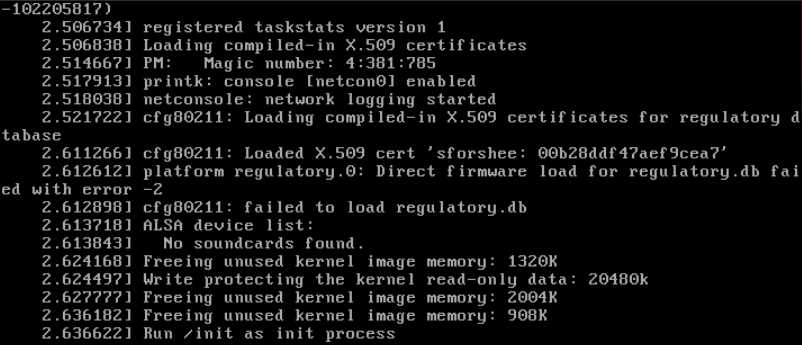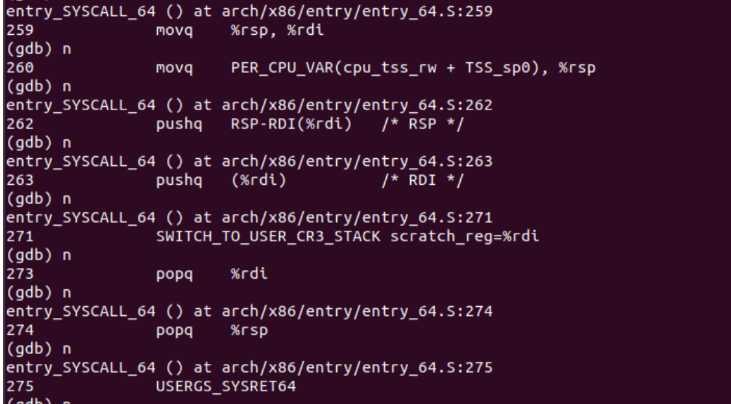标签:启动 type base div highlight 内容 zip idt find
(1)找一个系统调用,系统调用号为学号最后2位相同的系统调用
(2)通过汇编指令触发该系统调用
(3)通过gdb跟踪该系统调用的内核处理过程
(4)重点阅读分析系统调用入口的保存现场、恢复现场和系统调用返回,以及重点关注系统调用过程中内核堆栈状态的变化
(1)安装工具:
sudo apt install build-essential sudo apt install qemu # install QEMU sudo apt install libncurses5-dev bison ?ex libssl-dev libelf-dev
(2)下载内核源码:
sudo apt install axel axel -n 20 https://mirrors.edge.kernel.org/pub/linux/kernel/v5.x/ linux-5.4.34.tar.xz xz -d linux-5.4.34.tar.xz tar -xvf linux-5.4.34.tar cd linux-5.4.34
(3)配置内核编译选项
make defcon?g # Default con?guration is based on ‘x86_64_defcon?g‘
make menucon?g
# 打开debug相关选项
Kernel hacking --->
Compile-time checks and compiler options --->
[*] Compile the kernel with debug info
[*] Provide GDB scripts for kernel debugging
[*] Kernel debugging
# 关闭KASLR,否则会导致打断点失败
Processor type and features ---->
[] Randomize the address of the kernel image (KASLR)
(4)编辑内核
make -j$(nproc) # nproc gives the number of CPU cores/threads available # 测试?下内核能不能正常加载运?,因为没有?件系统终会kernel panic qemu-system-x86_64 -kernel arch/x86/boot/bzImage # 此时应该不能正常运行
(5)制作根文件系统
axel -n 20 https://busybox.net/downloads/busybox-1.31.1.tar.bz2
tar -jxvf busybox-1.31.1.tar.bz2
cd busybox-1.31.1
make menucon?g
#记得要编译成静态链接,不?动态链接库。
Settings --->
[*] Build static binary (no shared libs)
#然后编译安装,默认会安装到源码?录下的 _install ?录中。
make -j$(nproc) && make install
(6)制作内核文件系统镜像
mkdir rootfs
cd rootfs
cp ../busybox-1.31.1/_install/* ./ -rf
mkdir dev proc sys home
sudo cp -a /dev/{null,console,tty,tty1,tty2,tty3,tty4} dev/
(7)准备init脚本?件放在根?件系统跟?录下(rootfs/init),添加如下内容到init?件
#!/bin/sh mount -t proc none /proc mount -t sysfs none /sys echo "Welcome My OS!" echo "-------------------" cd home /bin/sh
(8)给init脚本增加可执行权限
chmod +x init
(9)输入下面代码查看qemu运行情况
#打包成内存根?件系统镜像 ?nd . -print0 | cpio --null -ov --format=newc | gzip -9 > ../rootfs.cpio.gz #测试挂载根?件系统,看内核启动完成后是否执?init脚本 qemu-system-x86_64 -kernel linux-5.4.34/arch/x86/boot/bzImage -initrd rootfs.cpio.gz

我的学号后两位是36,对应系统调用为getitimer

查阅资料知,getitimer系统调用的功能是:获取间歇计时器的值。系统为进程提供三种类型的计时器,每一类以不同的时间域递减其值。当计时器超时,信号被发送到进程,之后计时器重启动。
用法:
#include
int getitimer(int which, struct itimerval *value);
参数:
which:间歇计时器类型,有三种选择
ITIMER_REAL //数值为0,计时器的值实时递减,发送的信号是SIGALRM。
ITIMER_VIRTUAL //数值为1,进程执行时递减计时器的值,发送的信号是SIGVTALRM。
ITIMER_PROF //数值为2,进程和系统执行时都递减计时器的值,发送的信号是SIGPROF。
value,ovalue:时间参数,原型如下
struct itimerval {
struct timeval it_interval; /* 计时器重启动的间歇值 */
struct timeval it_value; /* 计时器安装后首先启动的初始值 */
};
struct timeval {
long tv_sec; /* 秒 */
long tv_usec; /* 微妙(1/1000000) */
};
getitimer()用计时器的当前值填写value指向的结构体。
返回说明:
成功执行时,返回0。失败返回-1,errno被设为以下的某个值
EFAULT:value或ovalue是不有效的指针
EINVAL:其值不是ITIMER_REAL,ITIMER_VIRTUAL 或 ITIMER_PROF之一
编写程序getitimer.c,使用getitimer来触发系统调用
#include <stdio.h>
#include <unistd.h>
#include <signal.h>
#include <string.h>
#include <sys/time.h>
#include <errno.h>
void PrintMsg(int Num)
{
printf("%s\n", "Hello World");
return;
}
int main(int argc, char* argv[])
{
signal(SIGALRM, PrintMsg);
struct itimerval tick;
tick.it_value.tv_sec = 10; //十秒钟后将启动定时器
tick.it_value.tv_usec = 0;
tick.it_interval.tv_sec =1; //定时器启动后,每隔1秒将执行相应的函数
tick.it_interval.tv_usec = 0;
//setitimer将触发SIGALRM信号
int ret = setitimer(ITIMER_REAL, &tick, NULL);
if ( ret != 0)
{
printf("Set timer error. %s \n", strerror(errno) );
return -1;
}
printf("Wait!\n");
getchar();
return 0;
}
将测试文件放在rootfs/home 目录下,进行静态编译,再在rootfs目录下重新打包。
gcc -o testge testge.c -static find . -print0 | cpio --null -ov --format=newc | gzip -9 > ../rootfs.cpio.gz
使用gdb系统跟踪调用

启动qemu
qemu-system-x86_64 -kernel linux-5.4.34/arch/x86/boot/bzImage -initrd rootfs.cpio.gz -S -s -nographic -append "console=ttyS0"
再重新打开一个终端,运行以下命令:
cd linux-5.4.34/ gdb vmlinux target remote:1234 b __x64_sys_getitimer c
在运行qemu的终端中,输入./getitimer即可开始单步调试。
系统调用的执行,是用户程序触发系统调用之后,CPU以及内核执行调用的过程。本次实验从调试源码的角度,调试了linux内核系统调用的过程,深刻理解了入口的保存现场、恢复现场和系统调用返回的过程,以及系统调用过程中内核堆栈状态的变化。
标签:启动 type base div highlight 内容 zip idt find
原文地址:https://www.cnblogs.com/yxud/p/12972381.html